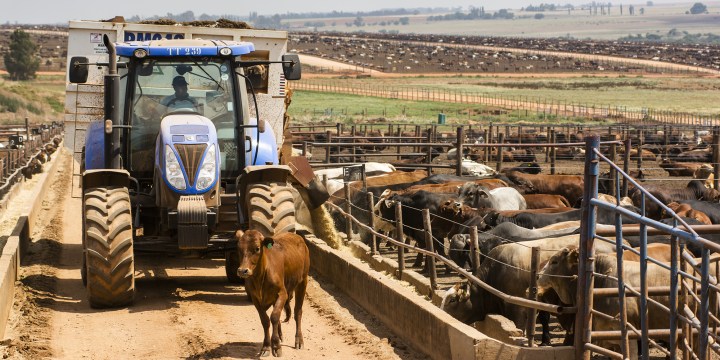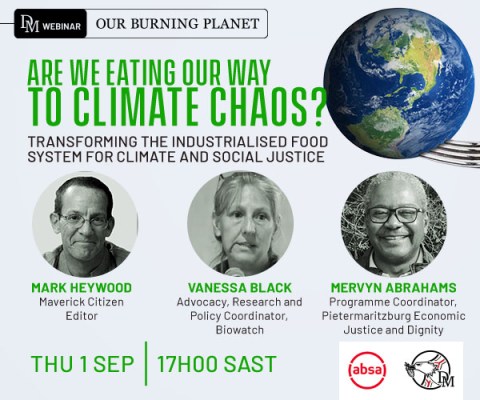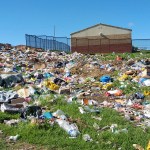
OP-ED
We urgently need to change how our food is produced, distributed, wasted and consumed to avoid climate chaos

Beyond being a major cause of climate change, the industrialised food system has externalised the cost of malnutrition and disease. It pollutes the air, water and soil through the mass application of pesticides and artificial fertilisers, and it is the key source of biodiversity loss.
To avoid the worst effects of climate change and secure a liveable planet, global temperature rises since pre-industrial times must be limited to 1.5°C. This means we have to halve global emissions by 2030. Quite rightly, much of our attention is focused on switching from fossil fuels to renewable energy sources as rapidly as possible.
Equally important, however, is the need to reduce the extensive emissions caused by producing and distributing what we eat.
According to analysts at the Stockholm Resilience Centre, every one of the 17 Sustainable Development Goals is directly or indirectly linked to the way we produce our food. The implication? Not transforming the industrialised food system will hold back the realisation of a fair and liveable planet.
Globally, through the increasingly industrialised food system is one of the single largest causes of climate change, generating one-third of greenhouse gas emissions.
As outlined in Biowatch South Africa’s latest fact sheet, 31% to 34% of the greenhouse gases emitted by human societies in 2019 were from the food system. This was in the form of carbon dioxide, methane and nitrous oxide — the latter two significantly more potent than carbon dioxide in their contributions to warming.
The largest emissions share of 25% comes just from farming — through deforestation to make way for crops or livestock grazing; the production of synthetic inputs used (such as fertilisers and pesticides); tilling the soil; and the application of chemical fertilisers.
Livestock production alone, and in particular industrial livestock production for meat and dairy, contributes 14% of total human emissions and is the single largest source of emissions from the food system. In fact, the combined emissions of the top five global meat and dairy companies together are on par with fossil fuel giants such as ExxonMobil. The consumption of meat and dairy is growing globally.
If energy systems are targeted for emissions reductions, but the livestock industry is left to grow as projected, the emissions from this sector will use 80% of the carbon budget available to keep emissions below 1.5°C.
Significant amounts of energy are also used pre- and post-agricultural production, creating 9% of human emissions, with the bulk taken up by food processing and packaging as well as by food-waste disposal.
Because of South Africa’s overreliance on coal for energy, the overall contribution of the food system to our emissions is slightly lower. However, at around one-fifth (18%) of total emissions, it remains a significant potential source of emissions reductions.
Transformation of the South African food system also needs to be part of a transformation of global food systems.
But this system, you might suggest, has enabled the world to produce more food, and at affordable prices, thus feeding the world, and so why should deep shifts be made? Are these not just some of the trade-offs we need to make? You might also ask how else we are supposed to feed a world population soon to reach eight billion people.

The industrial food factory
Through the ages, food has been about much more than simple energy to fuel our bodies. It is nourishment that shapes how we develop as human beings, embodies our cultural values and connects us in particular ways to our society, to the rest of nature and our past and future.
But the industrialisation of food has stripped food of its social value and its web of intricate connections to local ecologies and cultures, instead reducing the food system to delivering a narrow set of standardised commodities.
Like a factory process designed for mass-produced objects such as cars, the industrialised food system seeks uniformity and standardisation across the chain so that identical products are produced across time and place, and on a mass scale. At farm level, it therefore depends on genetically uniform monocultures.
This specialisation extends to animal genetics, where animals are bred for a single purpose, such as higher milk production or larger chicken breasts. This uniformity and mass scale enables massive profits for corporations, but reduces diversity in nature — and on the plate. It also significantly reorders our social relationships to food, as passive recipients of outputs from a production line, with little investment in its contents and form.
The industrialised food system has become a key global force in driving the ecological crisis. Beyond being a major cause of climate change, it has externalised the cost of malnutrition and disease. It pollutes the air, water and soil through the mass application of pesticides and artificial fertilisers and has degraded our soils to the extent that if current trends continue, the world will run out of topsoil in the next few decades. It is also the key source of biodiversity loss.
At the same time, the mass production of food to levels the world has never before seen has done little to address hunger and malnutrition.
Enough calories are produced globally that, if equally distributed, would provide each person on the planet with 1.5 times more than the daily recommended minimum calories. Yet the UN Food and Agriculture Organisation recently confirmed that more people than ever before, up to 828 million, are experiencing hunger, and 2.3 billion people remain food insecure.
Alongside this, obesity is rising, reflecting not only affluence in parts of the world but the increasing availability of nutrient-poor calories, such as simple carbohydrates. Food has long been entwined with global relations of power, economic growth and geopolitics, and with global systems of inequality that play a key role in determining who eats and who doesn’t.
South Africa’s unequal food system
Inequality is deeply implicated in food insecurity and hunger in South Africa — the most unequal country in the world — in two ways.
One is that a large part of the population does not have sufficient income to purchase food as a result of a combination of unemployment and low wages.
Before the Covid-19 pandemic, 20% of South Africans (12 million people) had inadequate or severely inadequate access to food. With rising food prices and a deepened unemployment crisis because of stringent lockdowns and the ensuing global economic crisis, by March 2021 35% of households could not purchase adequate food and 17% of households experienced consistent hunger. Today, 65% of the country’s population (38.7 million people) cannot afford a healthy diet.
The clear relation between policy and economic interventions and the sharp rise in hunger further clarify the extent to which hunger is a social — rather than an individual — problem, requiring a collective societal project that confronts the roots of injustice.
Second, the coexistence of deepened hunger on the one hand, and, on the other, the record profits of food corporations, retailers and the agriculture sector in the same period, raises questions of how deeply implicated South Africa’s industrialised food system is in the inequality and powerlessness that underpins hunger.
Our dominant, highly commercialised food system from which most people access their food represents in the eyes of many a virtue of efficiency, scale, modernity and development. Its construction, however, was made possible by the mass dispossession of black populations and their adverse incorporation into the economy, which still lies at the root of our inequality today. Those who produce our food — farm workers — are some of the poorest paid workers in the country and suffer some of the highest levels of food insecurity.
The support, marketing and distribution infrastructure that was built up by public funding to support a relatively small number of large-scale commercial farmers created a few tightly woven central actors in the food system that were privatised from the 1980s into the post-apartheid period. This represented a congealing of public support into privatised market power as a few, now corporate, actors controlled much of the food storage, distribution and marketing systems.
Today, although we have about 40,000 recorded commercial farm units, much of South Africa’s marketed food is produced by about 15,000 commercial farm units, which is distributed by a corporate-controlled distribution, processing, manufacturing and retailing network, with significant profits extracted from this control.
Such corporations exert significant influence over government policy, the market and our diets, shaping these in their favour, but often at the expense of the right to sufficient food, nutrition, health, small farmers and traders, as well as the environment. Rising prices of inputs mostly procured from global markets only further the trend of concentration, as survival and profitability depends on scale.
A key feature of the industrialised food system, including South Africa’s, is its global integration that has been driven less by human need and more by market imperatives. Because of this, mounting global shocks such as Covid-19 and the war in Ukraine are locking in rising food prices and supply-chain blockages.
Prices were already rising for many reasons before Russia’s invasion of Ukraine, one of them being speculation by financiers. This gambling and rising prices exacerbate inequality as the poorest already spend the majority of their income on food. Items such as cooking oil and bread, key staple components of food baskets for the majority of people, have risen by 34.3% and 11.3% respectively since this time last year.
The poor also need to pay for transport to purchase their food and public transport prices have risen by 12% since this time last year.
The confluence of the problems of our industrialised food system, climate change and the future of our country and planet are hardly more clearly illustrated than in the case of our children.
Due largely to malnutrition, the prevalence of child stunting is 27%. This has a fundamental effect on children’s later cognitive abilities and thus their work and life opportunities, and so also reproduces class and race inequalities.
At the same time, South Africa ranks as medium-to-high in the UN Children’s Fund Children’s Climate Risk Index, which measures children’s exposure to projected climate and environmental shocks and their overall vulnerability. Nearly one billion, or half of the world’s children, live in extremely high-risk countries.
The intersections between our food system and climate change form an integral connection to our planetary future through children and highlights the urgency of lowering emissions and building a food system that meets the nutritional needs of all in a climate-changed world.
Disconnection
The direction of our food system is being left largely to economic imperatives, which, in large part, explains its disconnection from human and planetary needs.
Government policy and action on the food system are weakly coordinated, and the recently finalised Agriculture and Agro-Processing Masterplan reproduces the view of the food system as simply another economic sector in which the aim is to boost overall production and create jobs. Considering the unemployment crisis, this is an understandable objective, but food is much more than simply an economic commodity. It is fundamental to human survival and a constitutionally enshrined right.
Shifting the food system requires acknowledging its multiple components and interconnections and the multiplicity of needs it should be serving. This instead requires a public project of transformation that mobilises society’s energies toward social objectives.
It also means moving beyond false solutions that anticipate the private sector will drive all hoped-for transformation, instead of democratised governance and decision making. It means looking beyond techno-fixes that centre privately owned technologies as holding the silver bullets to food system problems, but which reproduce the same thinking that caused the problems (like a domineering approach to nature) and invariably reinforce existing patterns of power and inequality.
Realising food systems that achieve social and climate justice will take interventions in a range of areas, including regulating corporate power, and actively shaping the consumer food environments within which households’ purchasing choices take place and make healthier and climate-friendly diets more accessible. This includes improving crop diversity and nutrition and investing in support for the production of marginalised indigenous and traditional crops to diversify away from emissions-intensive, non-climate resilient and less nutritious maize production.
It requires structural changes towards agroecology and food sovereignty that improve the ability of more people to participate in the food system from production to consumption and which include agrarian reform and policy governance that steers the functioning and outcomes of food systems towards socially just ends. This incorporates and supports multiple knowledge systems, and diversified agroecological production systems that build soil health and strengthen the human relationship with the rest of nature and all living beings through food.
Moving away from supporting climate-destroying industrialised food systems and towards just and diverse agroecological food systems should be seen as a major opportunity for building a better future for all.
Popular movements like the Agrarian Reform for Food Sovereignty Campaign, Inyanda National Land Movement and Rural Women’s Assembly have long argued for a redistribution of resources such as land and support for agroecology and local food systems as key to addressing hunger and marginalisation.
Abahlali baseMjondolo, the brave shack dwellers movement, illustrates the hopeful connections between the collective self-activity of the marginalised, food justice and social transformation. The Climate Justice Charter Movement has called for society to mobilise around, and the state to support, the building of food commons across villages, towns and cities.
The farmers that Biowatch supports in northern KwaZulu-Natal show how agroecological production enables food security and income from the marketing of produce in ways that build climate resilience.
Hunger and climate change will only be addressed through a fairer society. Building a fairer and more ecologically sustainable food system is a key component of that task. DM/MC
Andrew Bennie is a food systems researcher and activist, and a Biowatch Research Associate.
On Thursday 1 September at 5pm, Daily Maverick’s Our Burning Planet and Biowatch will host Are we Eating Our Way to Climate Chaos? — a webinar focused on South Africa’s industrialised food system and climate change. To be a part of the conversation, register here.
For more on this issue read:
UN Food Systems Summit was not destined to be perfect, but it made a landmark achievement




















 Become an Insider
Become an Insider
Andrew Bennie, a reed swaying in the wind, a lone voice in the wilderness, a prophet who will prepare the way before us but like John the Baptist he’ll probably lose his head, metaphorically speaking.
Beautifully written, Bennie captures the whole mood and tension behind industrialised food vs the whole, natural food movement.
Mealies, healthy whole grains, at R5000 a ton vs Cornflakes, highly refined, at R50,000/ ton?
And makes it clear that unless this prophet can develop a mass following it won’t be long before we are speaking of the late, once-great, Planet Earth.
Expect massive resistance, even persecution from the powers that be; Bennie and his followers are undermining Big Money.
Or is this just a conspiracy theory?